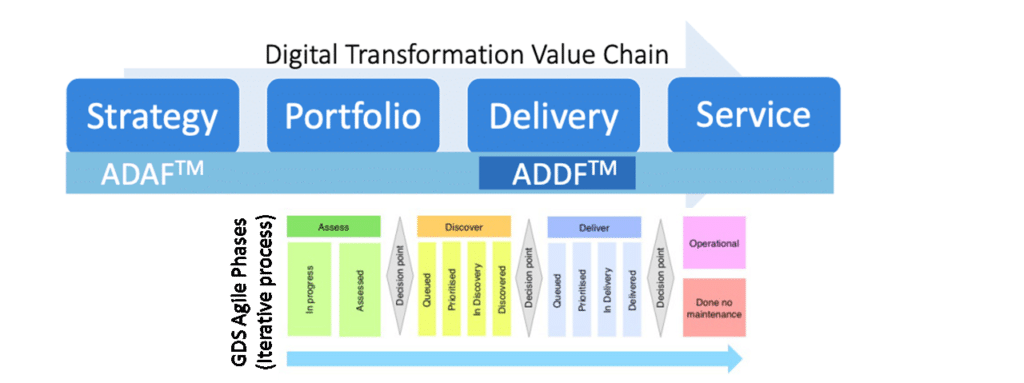Feel free to comment and subscribe to be notified when a new article is published.
Effective Architecture Standards and Frameworks for UK Government:

Introduction
Government Digital Services (GDS) is an organisation setting and enforcing standards for digital services, and providing best practice guidance and advice for consistent, coherent, high quality services. GDS advise to Government organisations is to use an Agile approach to deliver change called GDS framework. There are many aspects of agile architecture and design work to be considered like:
- The approach to programmes governance.
- Managing parallel work.
- Redefining roadmaps.
- Controlling change to the emergent architecture and alignment with the planned architecture.
- Enabling effective synergy between business, delivery and solution teams.
- Focussing on delivering high business value within a continuous delivery.
- There are many benefits that can be achieved through the introduction of Architecture Standards and Frameworks:
- Having full control over the architecture and design lifecycle.
- Reporting in near real-time the activities status.
- Aligning stakeholders of complex transformation programme across all levels.
- Delivering a solution that is aligned to the business cases, enterprise architecture strategy, plans, business and technical KPIs.
- Providing end-to-end design assurance and requirements traceability across all deliverables.
The GDS Framework encompasses the following phases:
- The discovery phase where business problems are understood and analysed.
- The alpha phase is where different options to solve the problems are evaluated and tested (e.g. via Proof of Concepts or paper-based exercises).
- The beta phase is where organisations take the best option from alpha and start building it for real.
- The live phase is about launching a live service and iterating it to and make improvements.
- A service eventually is retired, this is the last phase of the GDS framework.
GDS is also suggesting a portfolio management framework that is described here and we are mapping against our assurance framework in the sections below. For more details refer to the GDS Blog, Scaling Agile Practices to the GDS Portfolio.
In this article we provide an overview of proven Software Architecture Standards and Frameworks for mature software engineering practice. Outlining its applicability to UK Government guidelines, through the adoption of an Architecture and Design Assurance Framework (ADAF). ADAF naturally supports GDS portfolio management framework and beyond.
In a future article we’ll discuss best practice governance in an agile environment through the adoption of an Architecture, Design and Delivery Framework (ADDF), and the correct team structure. ADDF supports and complements GDS framework.
Overview of Software Architecture Standards and Frameworks of a mature organisation
A mature organisation should have access to a defined set of tools, processes, templates and team structures that enable effective assurance and delivery governance. Best practice and international Software Architecture Standards and Frameworks include:
- TOGAF
- IT4IT
- Archimate
- Scaled Agile (SAFe)
- GDS framework
- DevOps
- CI/CD (Continuous Integration/Continuous Delivery)
Undertaking digital transformation projects can provide some valuable lessons, for example:
- How to effectively tailor Architecture Standards and Frameworks.
- How to deliver high value sprints.
- The importance of defining correctly and timely a Minimum Valuable Product (MVP).
- How to manage fast-paced, parallel workstreams with ever-changing dependencies.
Architecture Standards and Frameworks can be tailored to bring benefits like:
- A reference enterprise architecture and design repository.
- Improving cost control, reducing inefficiency and reworking.
- Enabling efficient governance.
- Increasing return on investments.
- Achieving end-to-end scope traceability.
- Maximising the impact of the architecture team in the organisation.
For successful implementation, a mature organisation should adopt a lean Architecture and Design Assurance Framework like the one below.
Architecture and Design Assurance Framework
Successful adoption of an Architecture and Design Assurance Framework is assuring that the Architecture and Design team are involved in every aspect of the Transformation delivery lifecycle.
Strategy
This is where the organisation objectives are set by the business executives and IT directors. Architecture teams work with the Chief Architect and business stakeholders to define the architecture vision and strategy.
In this phase, architects support their clients to:
- Clearly define and align strategy with the architecture deliverables.
- Engage all levels of the organisation to effectively educate, listen and address concerns of business, technical and delivery stakeholders.
Portfolio (includes Assess and Discover GDS phases)
Architecture teams work with the Chief Architect and Enterprise Architects to shape the enterprise change portfolio to define portfolio roadmaps.
In this phase, architects support their clients to:
- Ensure that enterprise architecture roadmaps are defined and aligned with the strategy, objectives, and the sequence of programmes and programme releases in the portfolio.
- Plan activities and identify dependencies and reflect them on organisation programme plans.
- Assess the organisation structure and change management framework to make them ready to undertake digital transformation.

Delivery (includes Deliver GDS phase)
Architecture teams support Squads to define epics and identify their impact to the architecture landscape. Together, they define the architecture and design of the solution, making sure that software products meet technical and business requirements, follow best practice and comply with legal and regulatory standards. In this phase, architects support their clients to ensure that:
- PMO & Programme teams are in place.
- Solution Architecture and Design have access to the right tools, information and processes.
- Design assurance activities are correctly planned and executed.
- End-to-end requirements traceability is introduced.
- Release dependencies are correctly defined and managed.
- All aspects of migration are correctly defined and planned.
- The integration between applications is correctly defined and managed.
- Delivery artefacts, planning and quality are controlled.
Service (includes Operational GDS phase)
In this phase, architects help clients to:
- Ensure that service management is fully defined and ready to operate the live service.
- Secure the solution, so that the infrastructure can support the live service and the solution is ready for production and large-scale use.
Each organisation can be at a different level of Architecture and Design maturity. It is wise and advisable to involve expert Architects in assessing and planning the required improvements to uplift your organisation maturity and align it to best practice.
Our partner Bruhati have a successful track record in helping organisations through their Architecture Maturity Journey and working with Government in delivering strategic nation-wide change. For more information and a FREE consultation please visit www.bruhati.com or contact sales@bruhati.com.



